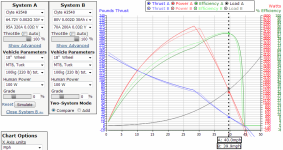crossbreak said:
what a discussion. minde, please read what john in CR and snowchyld wrote,
You read what TheManShaker asked about. There is emphases on low speed, torque from stand still, climb to hill.
Overall think about:
-different efficiency at low speed.
-about higher torque in low speed,
-about less load on battery in low rpm,
-better traction control on rear wheel (this might be not so relevant for most but still worth to consider when low speeds apply).
crossbreak said:
there is no such thing as a "high torque" or "high speed" motor. Different kV does not mean higher or lower torque or speed capability of the motor. It is just that simple. The magnetic circuit is the same, bearings are the same etc. Very simple to understand that they must be the same.
Actually there are things opposite of what you wrote.
It is simple indeed therefore true will come alive. No need to defend others opinion and simulators graphs (theory) instead try two different motors in real world. You will see and feel the difference then.
High or low Kv motors have the same torque but in different rpm range therefore different kV does mean higher or lower torque and speed capability of the motor.
Actually you even can see it in simulator. Low Kv better start torque. And if you ride steep, soft, rocky, rooty forests, you preffer higher torque in lower rpm range.
Imagine taking high Kv motor, riding it 30km/h, pouring Amps, generating heat, climbing slowly some steep, rocky terrain.
How many km / miles you ride compared with low Kv motor? Answer is: You will ride less amount of distance compared with low Kv motor when riding in low speeds and in difficult terrain.
On high Kv motor You can put FF and radiators but you will still be in disadvantage compared with low Kv motor and most importantly motor will behave differently in extremely low rpm range and of course it will have less torque.
crossbreak said:
Now to the practicle advise: Choose your controller according to your windings. When you only can effort a cheap one, then go for the low kV motor, it does not need many phase amps to reach the max torque the motor is capable of. But most likely your are then stuck to low speed. If you want to use the full potential of the motor you can
a) use a high kv motor (12kV) and a high battery voltage (96V) to get the same top speed. You dont need a controller with high phase current (only 100 amps), but one that can work with high pack voltage (rated for 110V max)
b) use a low kv motor (6 kV) and a normal battery voltage (48V for example). You need a controller that can do high phase current (200A), but it does not need a high voltage rating (55V max is sufficient)
system a) and b) will perform the same
You mixed it. Things are opposite.
Nevertheless I believe you intended to write it opposite regarding you a and b examples, but if you believe of what you wrote in a and b than you should know that it's wrong.
Roughly, talking into perspective of what you try to give example. Let's say:
You get 9kv and set it to 250A phase
Or
You get 13kv and set it to 350A phase
According what you wrote you get the same results. Nop, you don't get the same torque, because you get that ''same'' torque in different RPM.
Low Kv motor will pull better in low speeds. And if you need better efficiently ie less heat ie less ampsm, MORE torque on low speed than you use low Kv motor. You don't simply get highest possible Kv motor and set amps to roof and say that all motors has the same torque. I'm trying to give examples to the point where I get smile, it feels that I'm repeating the same thing but slightly from difference angle.
It's not only about controller price and how much phase it has. Two controllers can have the same max phase; same motors, kv; same batteries, but motors will have difference torque, especially from stand still. It's not only about max phase amps on paper.
crossbreak said:
@bionicon:
there is an rpm for every motor, where it feels healthy. This point can be calculated an thus the ideal reduction ratio for a given bike (weight, wind and tire drag)
You need:
Motor resistance
Kv
Eddy and hysteresis loss constants
dissipation ability in watts at the desired conditions (max air temperature for example 40°C, max motor temperature, for example 100°C )
plus the above mentioned values for the vehicle
Yes,
Low Kv motor is more efficient in Low rpm, and it is more torque in low rpm.
High Kv motor less torque in low rpm, less efficient in low rpm, more heat when it is less efficient.
You say that high and low Kv motor has same torque. Fine.
If you still think so then try 'qs 205 17 Kv' version motor in 26'' rim (or 17'' rim, it will be still sluggish in low rpm) with some 500 phase amp controller and go to some difficult terrain, rocks, roots, hills, maybe some snow or sand.


